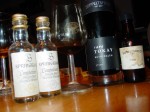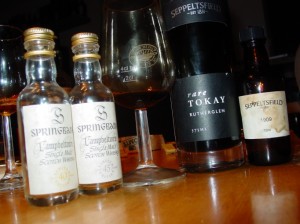For a long time, sweet wines were out of fashion here in Germany, but connoisseurs sticked to the wonderful Riesling Auslesen and the other worldwide high class elixirs of that kind. Sherry, Tokay and Port also sell much less in the English-speaking world today. Let me tell you, you missed out if you haven’t tried great sweet wines. The complexity of an old Sauternes, a Trockenbeerenauslese (Austria, Germany, Alsace), a Vin Santo, a great Port or other fine members of this category can be mindboggling. I just had three nice ones again:
Chateau Closiot 2006 Sauternes ASC 13,5%
Comment: 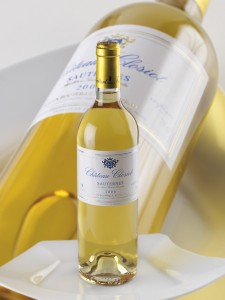 I could get a really cheap lot with Closiot 2005 (already reviewed) and 2006, which is said to be the better vintage. In general, I tend to go for the bigger names as it is really worth it with Sauternes/Barsac wines, e.g. Rieussec, Suduiraut and some other ones that really deliver.
I could get a really cheap lot with Closiot 2005 (already reviewed) and 2006, which is said to be the better vintage. In general, I tend to go for the bigger names as it is really worth it with Sauternes/Barsac wines, e.g. Rieussec, Suduiraut and some other ones that really deliver.
However I couldn’t refuse the good offer and received a good Sauternes that only lacks a little finesse and acidity to be a great one. Everything is there, but not as defined as in the great ones. This chateau (4,5 h) is historically attached to Chateau Coutet (classed growth).
Score: 89
Seppeltsfield ‚Rare Tokay‘ 1983 Rutherglen (AU), 17%
Comment: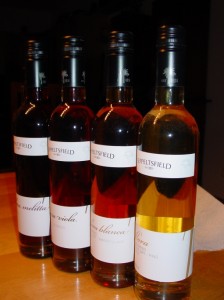 Rare stuff, this Tokay from Australia. Their vintage Ports that date back to the 19th century rank among the best sweet wines ever made. This Tokay is from their medium-aged stock. It boasts a mix of Australian wine aromas and dark cooked fruits (loads of raisins, some figs and blackberries as well). Dark chocolate and whiffs of tobacco complete the nose. It tastes very sweet, the soft acidity can’t counter that. Nice, but no stunner.
Rare stuff, this Tokay from Australia. Their vintage Ports that date back to the 19th century rank among the best sweet wines ever made. This Tokay is from their medium-aged stock. It boasts a mix of Australian wine aromas and dark cooked fruits (loads of raisins, some figs and blackberries as well). Dark chocolate and whiffs of tobacco complete the nose. It tastes very sweet, the soft acidity can’t counter that. Nice, but no stunner.
Score: 92
Seppeltsfield 1909 Para Vintage Tawny Port 100 y.o., 23,7%
Comment: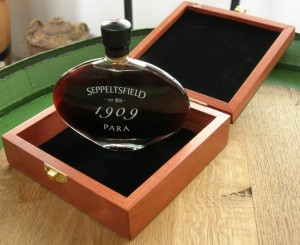 I had the sister cask from 1910 and score it at 100 points, my first full score (see here). This is also made from Mataro, Shiraz and Grenache grapes from Barossa Valley and matured in a Puncheon (500l) for 100 years. Again I am in awe. The colour alone is opaque olive brown with a green edge and the oily viscosity is amazing. But this is pricy stuff (37,5 cl for 1000 Aussie-Dollars). Let’s see if it can rival the perfect 1910: The nose is full of tar, resin, glue, cloves, Blaukraut (cooked
I had the sister cask from 1910 and score it at 100 points, my first full score (see here). This is also made from Mataro, Shiraz and Grenache grapes from Barossa Valley and matured in a Puncheon (500l) for 100 years. Again I am in awe. The colour alone is opaque olive brown with a green edge and the oily viscosity is amazing. But this is pricy stuff (37,5 cl for 1000 Aussie-Dollars). Let’s see if it can rival the perfect 1910: The nose is full of tar, resin, glue, cloves, Blaukraut (cooked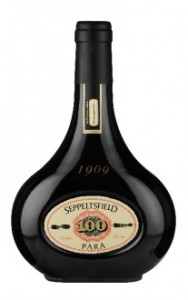 red cabbage from Germany) and coffee at first. Then there is a strong nutty character like in a fine Nocino, dark chocolate and balsamic whiffs. Great again, but not as complex as its sister. The ultra-big weight on the mid-palate is nutty and resiny with amazing acidity left after all these years. Morello cherries and dark chocolate join in for a great finale. High class, but I’d clearly go for the 1910.
red cabbage from Germany) and coffee at first. Then there is a strong nutty character like in a fine Nocino, dark chocolate and balsamic whiffs. Great again, but not as complex as its sister. The ultra-big weight on the mid-palate is nutty and resiny with amazing acidity left after all these years. Morello cherries and dark chocolate join in for a great finale. High class, but I’d clearly go for the 1910.
Score: 97

